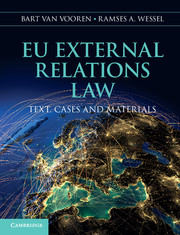Book contents
- Frontmatter
- Contents
- Table of cases
- Table of instruments and legislation
- Preface
- Acknowledgements
- List of abbreviations
- 1 The EU as a global legal actor
- 2 Instruments of EU external action
- 3 Existence of EU external competence
- 4 Nature of EU external competence
- 5 Scope and choice of EU external competence
- 6 The duty of cooperation
- 7 EU law and international law
- 8 The EU and international institutions
- 9 Common Commercial Policy
- 10 EU development policy
- 11 Common Foreign and Security Policy
- 12 Common Security and Defence Policy
- 13 The external dimension of the internal energy market
- 14 The external dimension of freedom, security and justice
- 15 The EU and its neighbours
- Index
- References
11 - Common Foreign and Security Policy
- Frontmatter
- Contents
- Table of cases
- Table of instruments and legislation
- Preface
- Acknowledgements
- List of abbreviations
- 1 The EU as a global legal actor
- 2 Instruments of EU external action
- 3 Existence of EU external competence
- 4 Nature of EU external competence
- 5 Scope and choice of EU external competence
- 6 The duty of cooperation
- 7 EU law and international law
- 8 The EU and international institutions
- 9 Common Commercial Policy
- 10 EU development policy
- 11 Common Foreign and Security Policy
- 12 Common Security and Defence Policy
- 13 The external dimension of the internal energy market
- 14 The external dimension of freedom, security and justice
- 15 The EU and its neighbours
- Index
- References
Summary
Central issues
The Union’s foreign and security policy is based on a set of compromises. From the outset, Member States have been hesitant to hand over powers in this area. Yet, the strong links with other policies as well as the single institutional structure caused an integration of CFSP into the Union legal order. While its distinct nature remains clearly visible, CFSP has become part and parcel of the EU’s external relations regime.
In this chapter we will address the historical explanations for the current place of CFSP in the EU legal order. We will analyse the attempts to start political cooperation before the 1990s and will assess the current provisions in that context. We will also address the role of the institutions (including the role of the CJEU) in CFSP as well as the decision-making procedures. Finally, we will assess the legal nature and function of the CFSP instruments.
Introduction
The CFSP of the EU has for decades been the ‘odd one out’. It emerged separately from the EEC in an incremental, pragmatic fashion at the beginning of the 1970s. The process was stimulated through the realization that the coordination of the different foreign policies of the (six, then nine, etc.) Member States was helpful, and occasionally even necessary, for the Community to pursue its goals. At present CFSP objectives have become an integral part of the overall objectives of the Union. Thus, this policy area has developed from a purely intergovernmental form of information exchange, coordination and cooperation in the days of the EPC, to an EU competence in its own right and an area in which the Member States have accepted significant forms of institutionalization and legalization.
- Type
- Chapter
- Information
- EU External Relations LawText, Cases and Materials, pp. 346 - 399Publisher: Cambridge University PressPrint publication year: 2014
References
- 1
- Cited by



